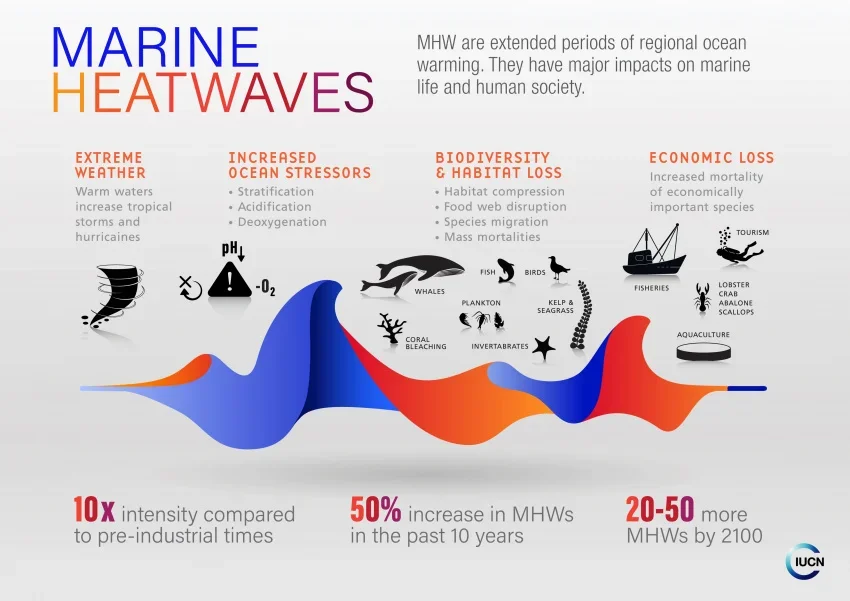Marine Heatwaves | 01 Aug 2025
For Prelims: Marine Heatwaves (MHWs), Sea Surface Temperatures, El Nino, Pacific Decadal Oscillation (PDO), Gulf Stream, Kelp Forests, Seagrass Meadows, Coral Reefs, Marine Protected Areas (MPAs), Wetlands, UNCLOS, UN Decade of Ocean Science (2021-2030), UN Plastic Treaty.
For Mains: Marine Heatwaves, its causes and consequences, Steps needed to curb marine heatwaves.
Why in News?
Scientists have found that the marine heatwaves (MHWs) affected 96% of the ocean surface in 2023, raising fears of a permanent temperature shift that could disrupt life in oceans and on land.
What are Key Facts Regarding Marine Heatwaves?
- About: A MHW is an extreme weather event marked by sea surface temperatures rising 3 to 4°C above average in a specific region for at least five days. It can persist for weeks, months, or even years.
- Key Causes of MHWs:
- Global Warming: Rising CO₂ levels trap heat, warming the ocean surface and depths, while oceans absorb 90% of excess heat, increasing the risk of MHWs.
- El Nino: El Nino warms upper ocean layers, weakening upwelling and trapping surface heat, while the Pacific Decadal Oscillation (PDO) amplifies marine heatwaves by shifting Pacific temperature patterns.
- PDO is often described as a long-lived El Nino-like pattern of Pacific climate variability.
- Reduced Cloud Cover: With fewer clouds, more sunlight reaches the ocean, causing rapid surface warming e.g., Atlantic heatwaves of 2023.
- Changing Ocean Currents: Changes in ocean currents like the Gulf Stream can raise regional sea temperatures, worsening marine heatwaves. E.g., a weaker Gulf Stream has caused warmer waters along the US East Coast, affecting hurricanes and sea-level rise.
- Human-Induced Feedback Loops: Arctic warming melts reflective sea ice, exposing dark waters that absorb more heat, while coral die-offs reduce CO₂ absorption, accelerating global warming.
- Projected Trends: The ocean’s average temperature has risen by 1.5°C over the past century, and by 2100, MHWs could become up to 50 times more frequent than in preindustrial times.
What are the Effects of Marine Heatwaves on Oceans and Climate?
- Climatic Impacts: MHWs can fuel extreme weather such as tropical storms and hurricanes, and disrupt the water cycle, increasing the frequency and intensity of floods, droughts, and wildfires.
- E.g., Hurricane Ian, a Category 4 storm, in Florida, US.
- Economic Impact: MHWs impact aquaculture as farmed species require stable temperatures, and harm fisheries by driving species away from warming waters, affecting local economies.
- E.g., Decline is recorded in key species like lobster and snow crab (Northwest Atlantic) and scallops (Western Australia).
- Ecological Consequences: MHWs cause mass mortality of invertebrates, disrupt food webs, trigger wildlife behavior changes (e.g., whales entangled in gear), and promote the spread of invasive species, threatening native biodiversity.
- Kelp forests, seagrass meadows, and coral reefs are highly vulnerable to MHWs. E.g., the 2011 MHW event off Western Australia caused ecosystem collapse and local extinctions over hundreds of kilometers.
- Compounding Environmental Stressors: MHWs often coincide with ocean acidification, deoxygenation, and overfishing, creating combined pressures that worsen habitat destruction.
How Can We Prevent and Mitigate Marine Heatwaves?
- Strengthen Ocean Monitoring: Expand marine monitoring systems and enhance climate modelling to improve real-time tracking and accurate prediction of MHWs.
- Protect and Restore Marine Ecosystems: Conserve coral reefs and mangroves, establish Marine Protected Areas (MPAs), and restore degraded coastal zones like seagrasses, salt marshes, and wetlands that absorb CO₂ to boost ecosystem resilience and biodiversity.
- Advance Sustainable Fishing and Aquaculture: Promote climate-resilient aquaculture with heat-tolerant species and sustainable feed, and develop early warning systems to alert fishing communities about MHWs.
- Enhance Global Cooperation: Strengthen Paris Agreement commitments, support vulnerable nations with climate finance and technology transfer, and promote global ocean governance through treaties like UNCLOS and the UN Decade of Ocean Science (2021-2030).
- Reduce Greenhouse Gas Emissions (GHGs): Transition to renewables, implement carbon pricing, and promote sustainable transport and industries to cut emissions and combat climate change.
- Reduce Local Stressors on Oceans: Reduce ocean stressors by curbing pollution through the UN Plastic Treaty and sustainable farming, and cool ocean surfaces using reflective infrastructure and artificial upwelling.
Conclusion
Marine heatwaves threaten ocean health, weather stability, and coastal economies. Combating them requires global emission cuts, marine ecosystem protection, and advanced monitoring. Without urgent action, MHWs will intensify, causing irreversible damage to biodiversity and human livelihoods. A coordinated climate-ocean policy is essential to safeguard our oceans and future.
|
Drishti Mains Question: "Marine heatwaves are emerging as a silent crisis for ocean ecosystems." Discuss their causes, impacts, and mitigation strategies. |
UPSC Civil Services Examination, Previous Year Question (PYQ)
Prelims
Q. With reference to Ocean Mean Temperature (OMT), which of the following statements is/are correct? (2020)
- OMT is measured up to a depth of 26ºC isotherm which is 129 meters in the south-western Indian Ocean during January-March.
- OMT collected during January-March can be used in assessing whether the amount of rainfall in monsoon will be less or more than a certain long term mean.
Select the correct answer using the code given below:
(a) 1 only
(b) 2 only
(c) Both 1 and 2
(d) Neither 1 nor 2
Ans: (b)
Mains
Q. Discuss global warming and mention its effects on the global climate. Explain the control measures to bring down the level of greenhouse gases which cause global warming, in the light of the Kyoto Protocol, 1997. (2022)
Q. Assess the impact of global warming on the coral life system with examples. (2017)

